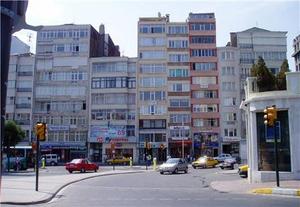DisastersNew law aims to make Istanbul earthquake-safe, but it has its critics
Estimates of Istanbul’s population range from twelve and nineteen million people, a significant increase from two million people fiftyyears ago; during the waves of migration to Istanbul during the 1960s,1970s, and 1980s, the government gave citizens free permitsto add to their homes, which resulted in single-story residents becoming 4-or 5-story buildings on unstable foundations; Istanbul sits only thirteen miles north of the North Anatolian Fault, the intersection of the Eurasian and Anatolian plates, and has been subject to devastating earthquakes; new, controversial law aims to make Istanbul’s buildings earthquake-safe

Buildings in Istanbul likely to collapse during an earthquake // Source: purdue.edu
Yasin Kenar knows that the neighborhood where he grew up will face a serious disaster if an earthquake were to hit.
“This one is not safe,” he says, pointing to a five-story apartment building in Sumer. The top four floors jut out like a rib cage over the foundation. “And that one and this one.”
According to Kenar, if a major earthquake struck Istanbul, one-third of the buildings on his street would collapse. The walls of his balcony have deep cracks left over from a 7.6 magnitude earthquake that struck the province of Kovcaeli, forty-three miles from Istanbul, in 1999. The Alaska Dispatch reports that the quake killed more than 17,000 people and left almost half a million people homeless. 120,000 poorly constructed houses were damaged beyond repair and another 50,000 were heavily damaged.
“My building is not safe. I am a million percent sure that the building is not strong [enough for an earthquake],” Yasin told the Alaska Dispatch. “If we will not be ready for an earthquake, too many buildings will fall down and too many people will die.”
City officials know neighborhoods like Sumer could be in serious trouble in the event of an earthquake, the buildings are far from up to code and the streets are so narrow that fire trucks and other emergency vehicles cannot drive down them.
Authorities are now attempting to reconstruct neighborhoods like Sumer, which are extremely vulnerable, but the quest for a safer Istanbul is not without controversy as many residents will be forced to give up their homes. Human rights groups are concerned the reconstruction plans are a backdoor to gentrification rather than ensuring the safety of the residents.
For the last few decades, buildings in Istanbul, Turkey’s largest city, have been constructed with scant regard, if any, to building codes and regulation. Officials estimate that 2,300 buildings, or about 15,000 apartments, in the district of Zeytinburnu, which is only one of Istanbul’s thirty-nine districts, would be destroyed in an earthquake.
The picture is grim: civil engineers predict that some two million of Istanbul’s three million residential buildings are at risk. Successive governments have tried to rebuild buildings and neighborhoods so they would have a better chance of withstanding an earthquake, but residents objected to these efforts, so there has been no progress on making Istanbul more secure.
Now Sumer is set to be the poster child for the redevelopment plan. Akif Levent, an engineer with Istanbul’s Metropolitan
